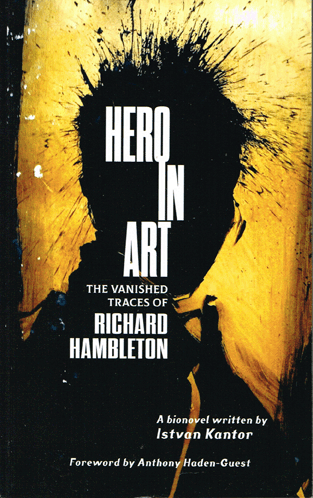
2020.01.06 Hero in Art - The Vanished Traces of Richard Hambleton

Yes, I knew Richard Hambleton &, yes, because of that I'm mentioned in passing in this book. I started exchanging correspondence with strangers in 1978. Most participants in this process called it "Mail Art" but since I'd eschewed the context of art I preferred "P.I.N.-U.P." (Postal Interaction Network - Underground Participant). As far as I know, I'm the only person who ever used that acronymn. When Richard & I connected it was still back in the day when I was sending out gratis copies of my 1st book (published 1977). I keep records on 4X6" cards of who I correspond with & listing what I send them & what they send me. My correspondence with Richard didn't last long because when he changed address in NYC I didn't learn where he'd moved to. I heard various stories about him that led me to believe he'd 'gone down the rabbit hole' & that we weren't likely to connect again.
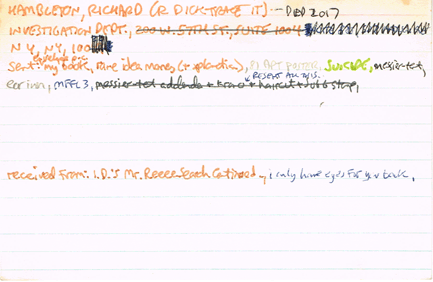
BUT during the admittedly brief time of our friendship, roughly 1981, I enjoyed his work & his company very much. As Istvan Kantor remembers, we probably met in BalTimOre 1st during "81 APT", the 3rd International Neoist Apartment Festival & the 1st one I organized. Here're my 2 cameo appearances that give Istvan's memories:
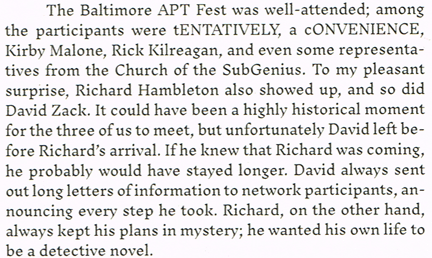
David lived with me at the same place where the APT was & I recall him staying there for a whole month. I remember (or misremember) him being there for the whole APT. As such, he would've been there when Richard was. I DO remember Richard's appearance as being much more brief, at least a few days but probably not for the whole festival.
As for other aspects of the above description: Kirby Malone did participate & initially he & I had discussed coorganizing the festival but in the long run it was basically (dis)organized by me. The fact that there was no money for it, etc, is a testimony to how committed the participants were. Ricky Kilreagan's performance with Some Queer as what was probably the 1st manifestation of N.E.M.B. (Non-Erotic Male Bonding) was excellent & in some ways a precursor to my own booed usic of 2.5 years later. Many of the locals were involved with the Church of the SubGenius at this point (or soon to be): myself, Richard Ellsberry, Doug Retzler, & Lizard. The highlight of anything SubGenius related were 16mm films sent to me by the Reverend Ivan Stang from, at that time, Dallas, Texas.
My vaudeo quasi-documentation of the festival is online following the links below. Unfortunately, Richard Hambleton never shows.
013. a. "81 Apt" {version 1}
- shot by tENTATIVELY, a cONVENIENCE (1/2" reel vaudeo), Lizard Media Systems (1/2" VHS cassette), & Mannette Letter (super 8) -> edited to 1/2" VHS cassette by tENTATIVELY, a cONVENIENCE
- 2:00:00 [not "worth" presenting]
- may-june '81 (etc..)
b. "81 Apt" {version 2}
- 32:00
c. "81 Apt" {version 3}
- dramatically re-edited using audio tape & scans & titles & brightness & contrast adjustments, etc..
- broken into 9 parts, one for each day of the festival (except from Monday, June 1, when, as far as I can tell, 'nothing' happened) - w/ the 1st day abridged, for YouTube:
- edit finished february 3, 2010
- 1:06:31
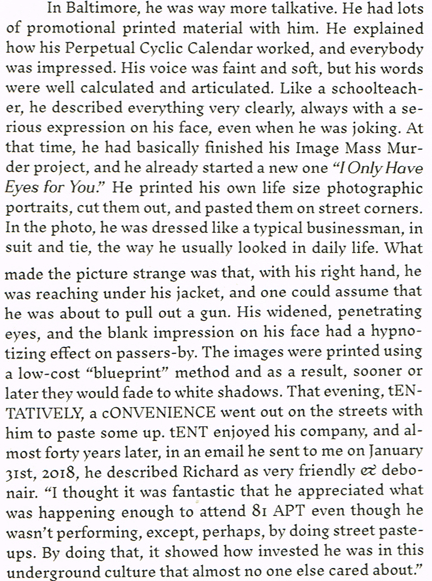
The 'blueprint' (strictly speaking a blackprint - the same thing as a blueprint but using black ink) of his roughly life-sized self-portrait was both used as a guerrilla paste-up AND as an artist's book that came neatly folded & bound so that one could unfold it to its full glory & still have it attached to its binding. I was fortunate enough to get 3 of Richard's wonderful publications, including the self-portrait - which came in this form:
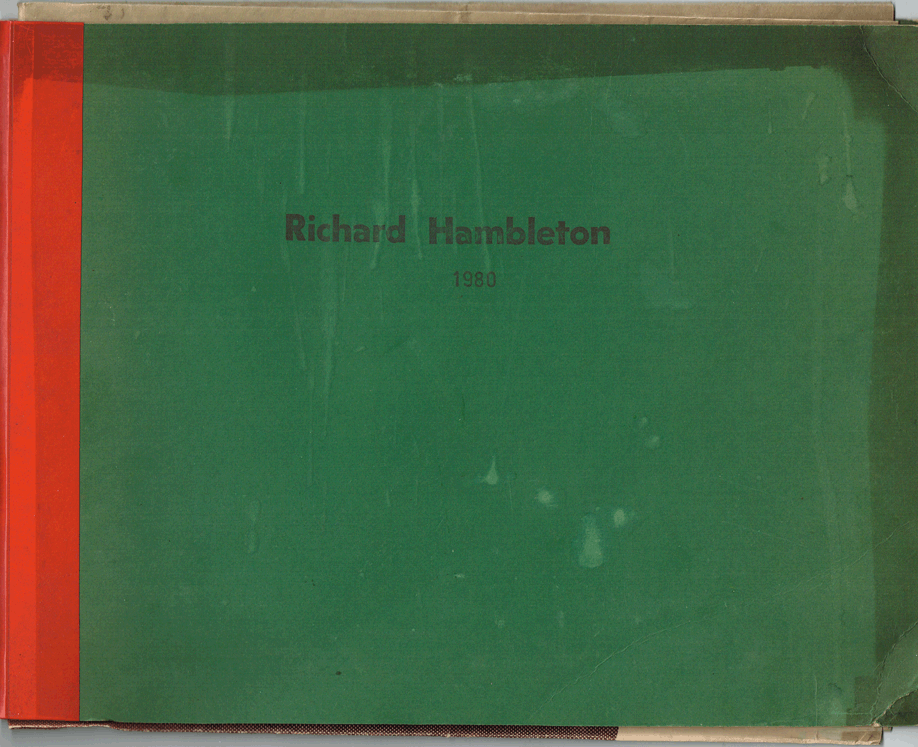
Despite the smoke damage visible in the above photo, an effect of having my apartment set fire to in 1985, I've managed to keep Richard's self-portrait blackprint relatively unexposed to light so it hasn't faded much over the decades.
Ricky Kilreagan, mentioned above as an 81 APT participant, also participated in the Public Works festival in Toronto soon thereafter. That was the 1st half of the 4th International Neoist Apartment Festival, the 2nd half of which was in Montréal immediately after the Toronto event. I attended both. I must've gotten the next photo from Istvan, probably to show me that Hambleton attended APT 4 in Montréal as well as 81 APT.
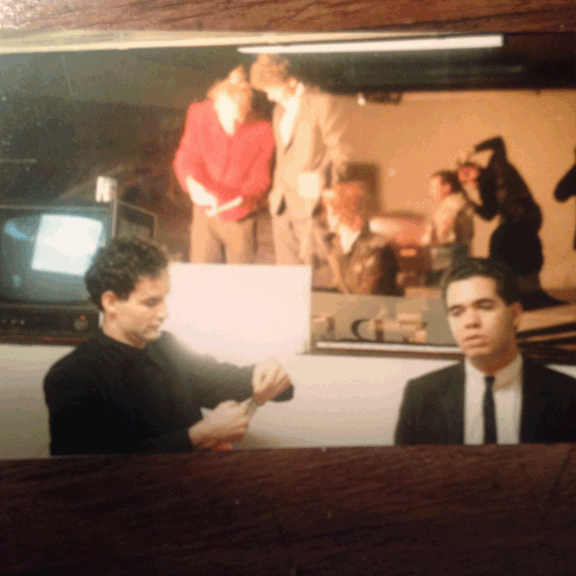
Shown in the forefront of the photo are Richard on the left & Napoleon Moffat on the right.
I'm shown in the background left wearing a red fake fur. I seem to be showing Richard something but it might be someone else. I don't recognize the other 3 people but I find them intriguing.
Since I grew up in the depths & general environ of that exemplary working class hell-hole BalTimOre, where drug addiction & race war have ruled the day for entirely too long & where if you have imagination you're valued as much as dog shit in bed (unless you're rich - in which case you stand some chance of being overvalued), it wasn't unusual for me to know people who were desperate to move to New York City where there was the very feeble hope that their talents might yield wealth & popularity. What they were most likely to encounter was dramatically overpriced rent & their old pal from BalTimOre, heroin addiction. Richard Hambleton, not from BalTimOre, was the only person I knew who got somewhat famous for his painting & who reputedly sold paintings for reasonable amounts of cash.. with which he became a junkie. Oh, well.
When Istvan was planning this book he asked me for a photo of myself with the blackprint of Richard so I enlisted my friend Julie Gonzalez to shoot a series of them for him. He wasn't satisfied with the resolution of those so he asked us to shoot some more. We did. Still not satisfied, he requested a 3rd set. We complied. I think he picked the following photo as his favorite. The plan was to use it in the book.
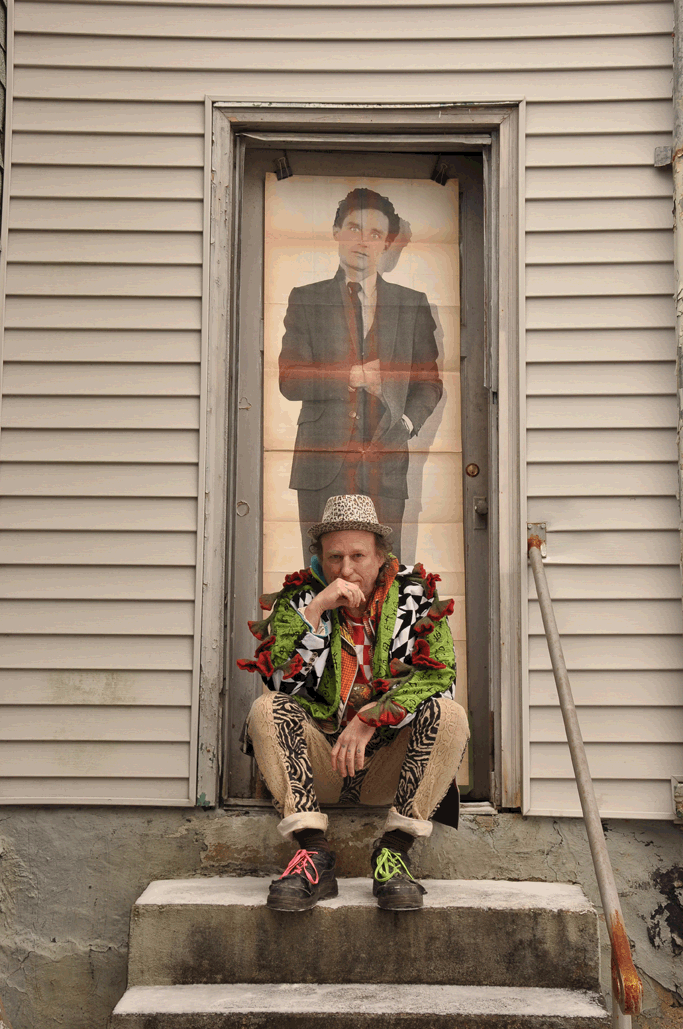
As I recall, I think Istvan liked this one because it evoked for him Richard as my bodyguard reaching for a gun. Richard's grafitti art had a vague menace to it. Imagine looking in an alley & seeing this figure apparently reaching for something where a gun might be. In dim light the image might've seemed like a threatening real person. Richard was a very soft-spoken nice person in my experience. I've imagined him as liking to imply a 'dark side' to his character. As it turned out, he did lead a pretty self-destructive life, becoming a heroin addict & neglecting his health to the point that in his final years his scoliosis had him bent sideways & he no longer had a nose - a far cry from the debonair young man shown above.
As it turned out, none of the photos were used in the book. As such, with my usual tedious thoroughness (not adequately displayed in the above text) I present all of the photos, including the ones that were cropped (which I've left larger because I thought they were the best).
- November 3, 2020 (Vision) notes from tENTATIVELY, a cONVENIENCE
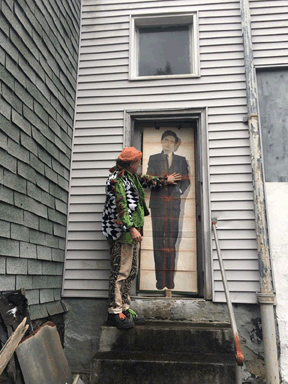
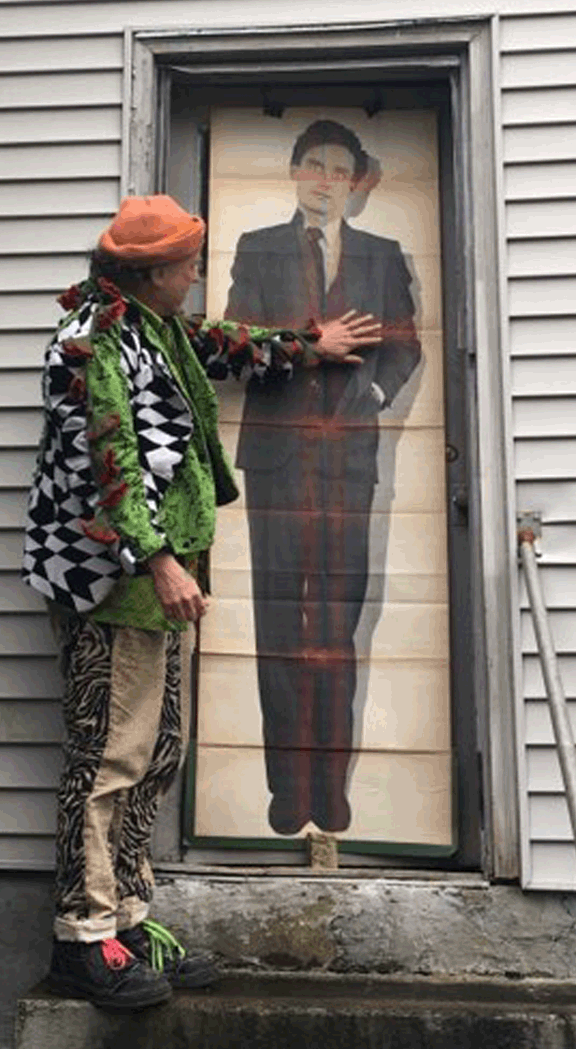
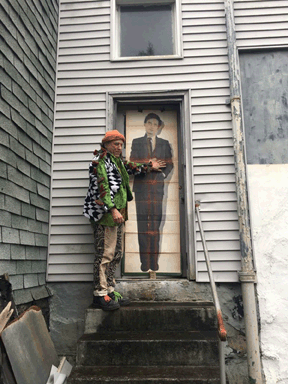

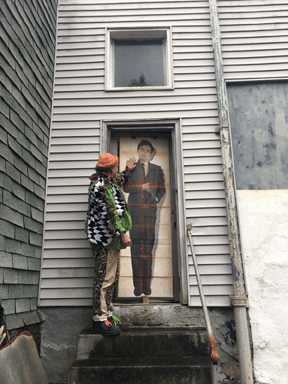
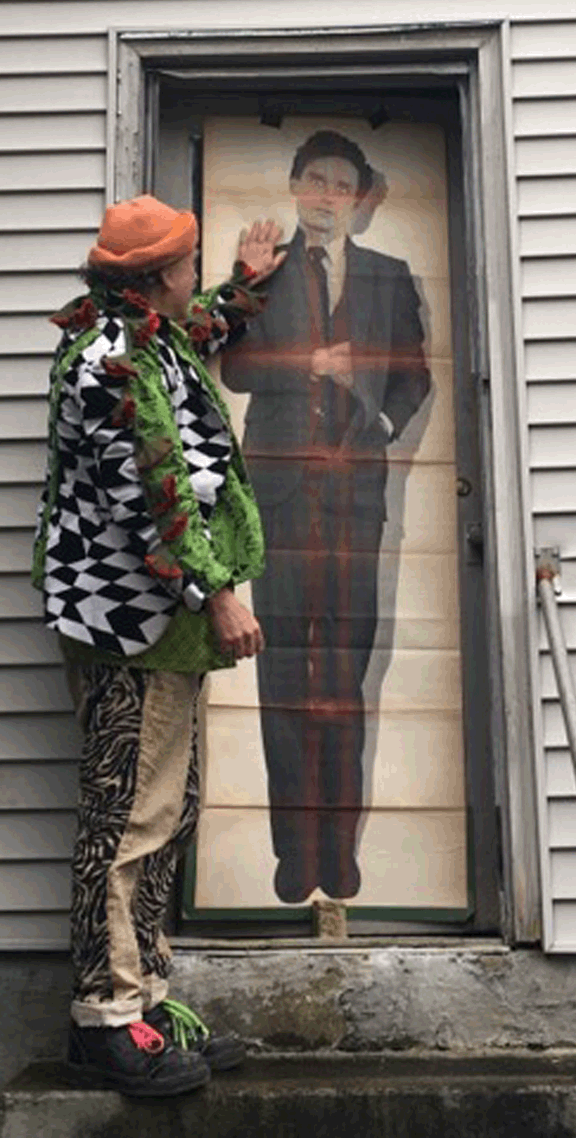
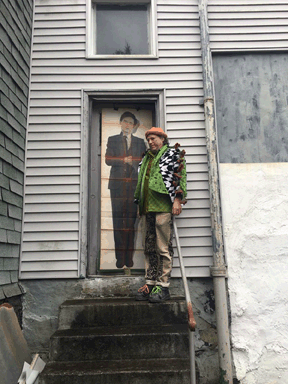

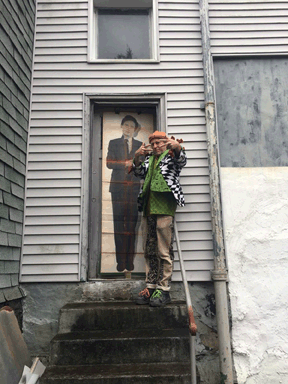
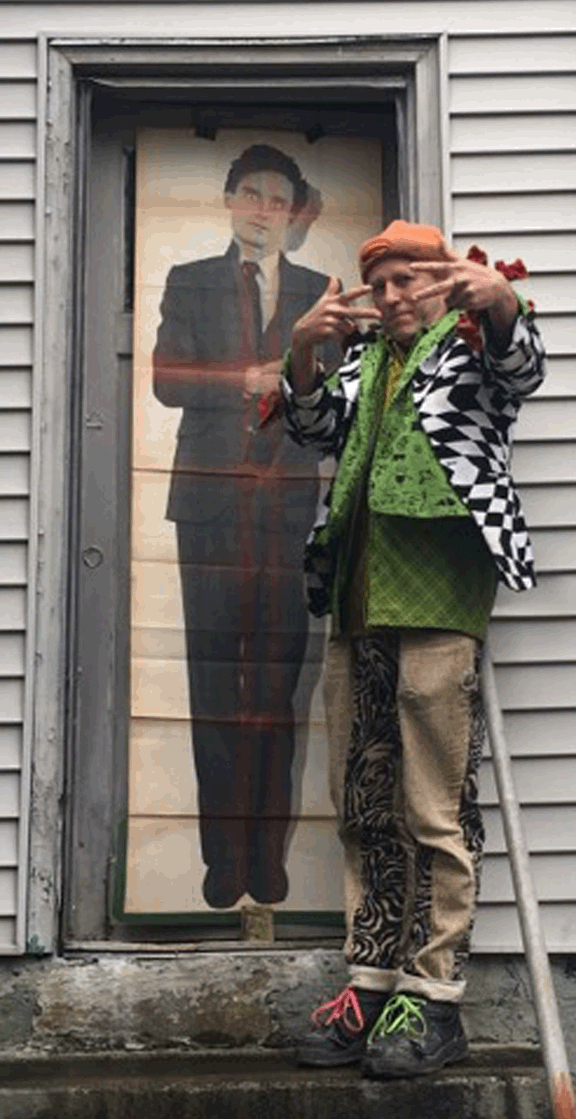
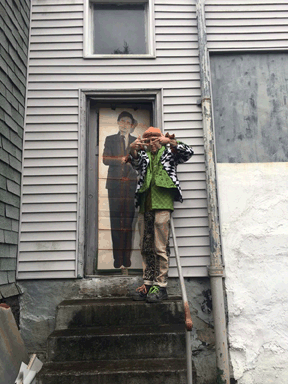
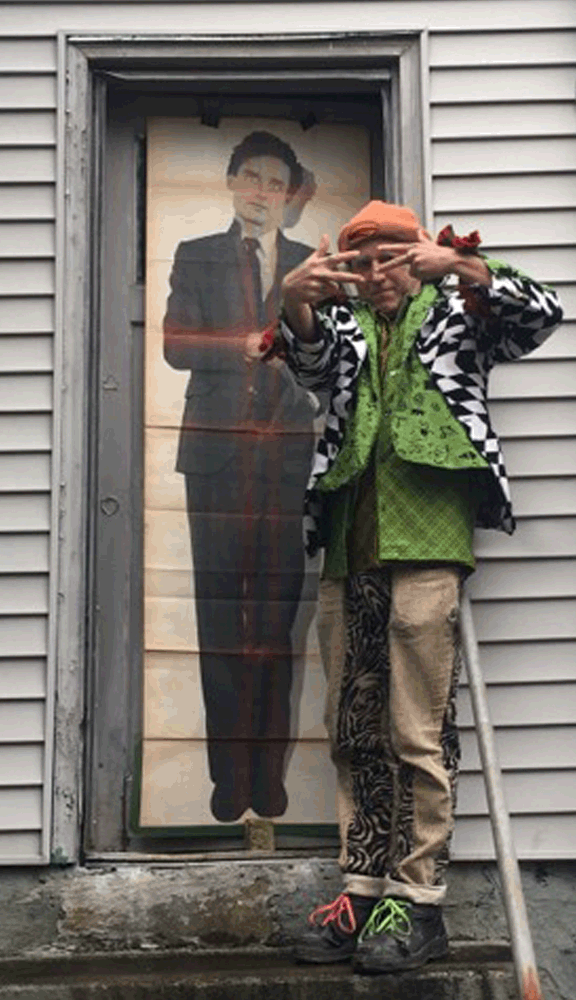
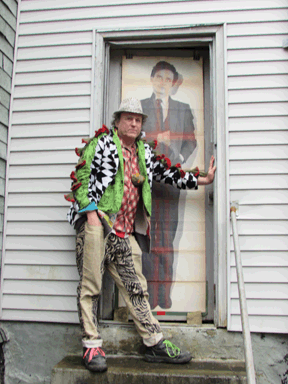
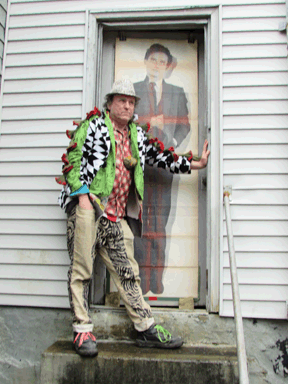
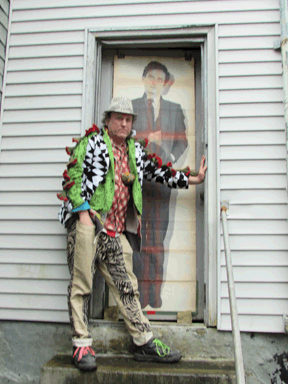
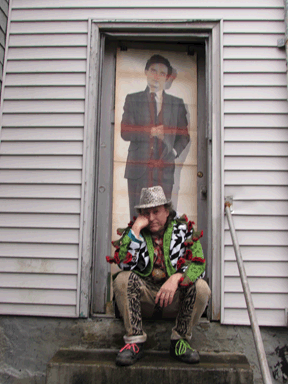
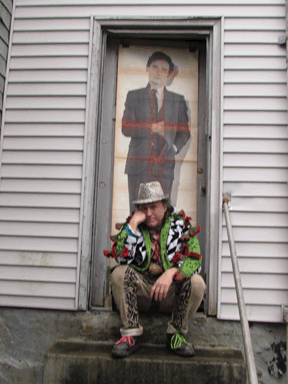
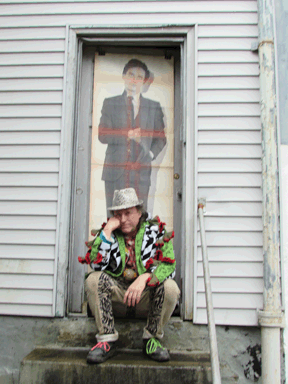
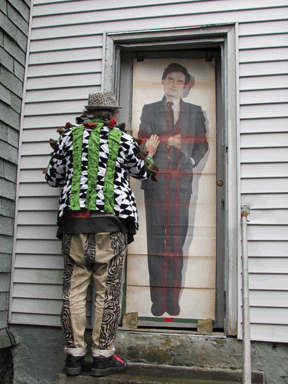
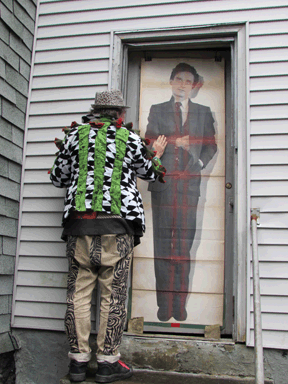

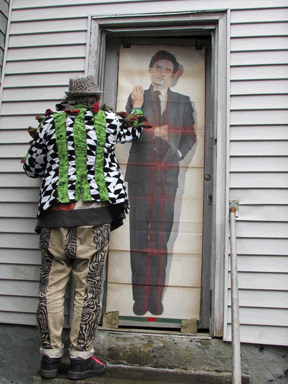
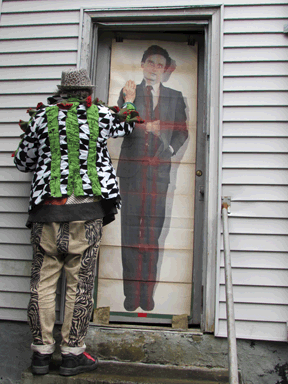

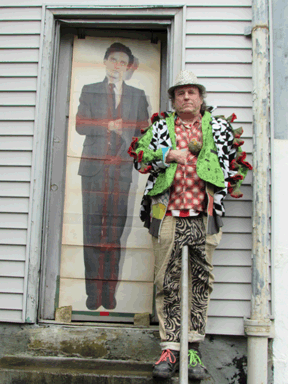
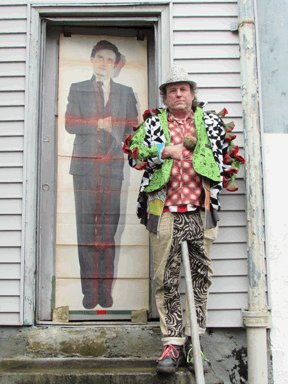
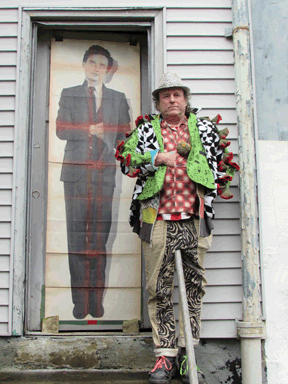
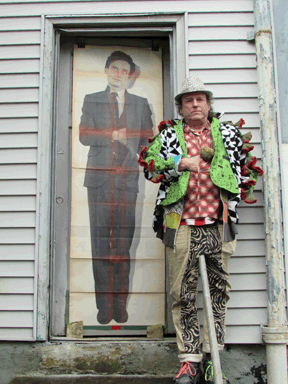
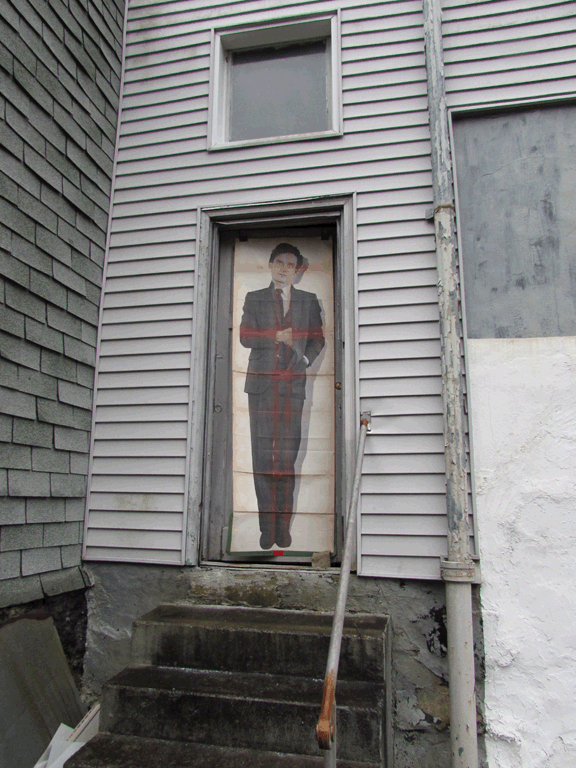
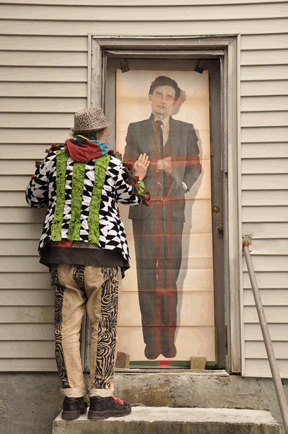

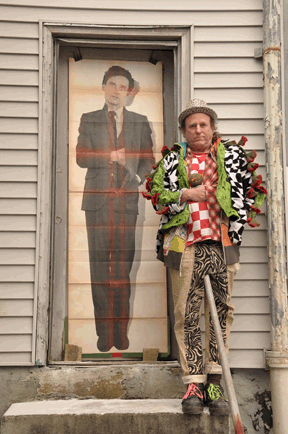
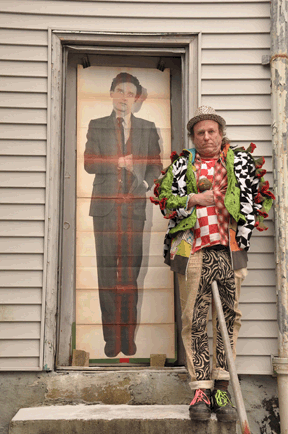


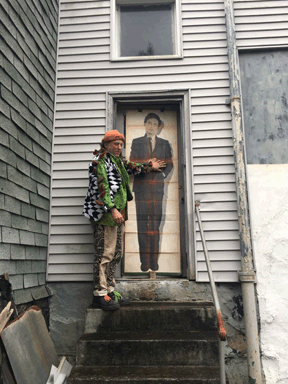
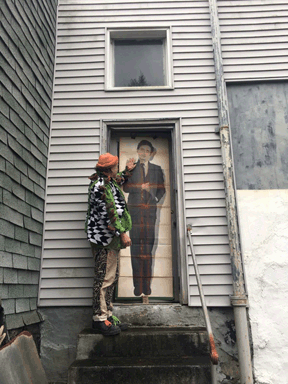


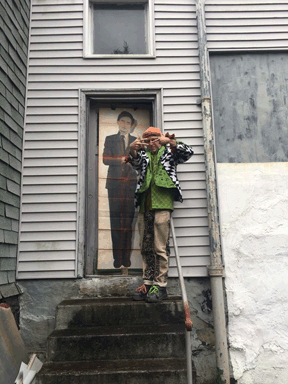
review of
Istvan Kantor's "Hero in Art - The Vanished Traces of Richard Hambleton"
2154. "review of Istvan Kantor's "Hero in Art - The Vanished Traces of Richard Hambleton" "
- the complete version of my review
- credited to: tENTATIVELY, a cONVENIENCE
- published on my "Critic" website March 15, 2023
- http://idioideo.pleintekst.nl/CriticHambleton.html
review of
Istvan Kantor's "Hero in Art - The Vanished Traces of Richard Hambleton"
by tENTATIVELY, a cONVENIENCE - March 13-14, 2023
For the complete review go here: http://idioideo.pleintekst.nl/CriticHambleton.html
It's often difficult for me to write reviews (even though I've written over 1,600 of them). Sometimes I prefer to write reviews of bks that few or no other people will write about. Whether this bk is in that category or not I don't know but I suspect that it is. The author is a former friend of mine who it's easy for me to be hyper-critical of - but I've had some excellent times w/ him too so I try to keep those in mind. The subject of this bk was also a friend of mine, albeit not a close one & only from about 1980 to 1983, after wch I lost touch w/ him.
I don't consider Richard Hambleton's life to be 'heroic', I consider it to be tragic. He destroyed his life w/ heroin addiction & his health was further destroyed by scoliosis - something that cd've been prevented if he'd taken better care of himself.
I'm originally from Baltimore, a small city only a few hundred miles from New York City where it was common for artists to want to move to New York where they hoped to become famous. However, once they moved to New York it was common for these aspiring artists to find themselves mired in extravagant rents for slum apartments in areas where heroin & cocaine were easly bought & where addiction was much easier to achieve than fame. While there were plenty of amazing cultural things to experience in NYC people cdn't necessarily afford to spend much time enjoying them b/c they'd have to work long hrs at shitty wages just to make ends meet. Richard Hambleton was the only person I know who actually 'made it', who started to sell his artworks for prices that cd get him out of the economic cesspool - but he squandered the money on the addiction he picked up quickly along the way. That's tragedy.
There's a foreword by Anthony Haden Guest. He got to know Richard sometime in the '80s. He quotes him:
""This is the first piece of public art I ever did," he told me, holding up a pocket mirror. He said that he had stuck up some mirrors all over Vancouver, including the text: Have You See This Face Before? He put up this work under the name of R. Dick Trace-It" - p 5
Perhaps Hambleton's art cd be divided into 3 phases: Mail Art, "Outdoors Art" (as Hambleton is reputed to've preferred over the more common Street Art or Graffiti), & the "beautiful paintings" (sd to be Turner-esque). I'm only familiar w/ those 1st 2 phases. The above-described use of mirrors is wonderful to me & exemplary of Richard's innovativeness as a guerilla artist.
"Image Mass Murder, which he made by drawing chalk outlines on the ground to indicate a murder victim and splashing red paint around it, and which he pulled off in fifteen cities of Canada and the US, had been his first public breakthrough and it is no wonder, as Kantor/Cantsin makes plain, that Richard Hambleton was none too happy when he was categorized as either a graffiti artist or a street artist. "Outdoors art" was his preferred term." - p 6
I, personally, see nothing wrong about the terms "Street Artist" or "Graffitist" but I can appreciate people having their preferred deviant lingo since I do the same.
In Kantor's preface he says:
"Richard told me, during our very last conversation on Orchard Street in 2015, that he always thought that one day I'd become the head of New York's criminal organization and take control of the city. I guess my early museum interventions and police arrests inspired his mind to come up with this fantasy. At that time, both of us were young and ambitious, with a vivid fantasy of taking over the city and making history ourselves." - p 15
Richard's purported fantasy of Istvan as a crime lord just shows how delusional he was. As for the fantasy of "taking over the city"? I find it hard to relate to such a desire for power but it plays into the author's frequent self-designations as things like "The Leader of the People of the Lower East Side" - a position that, as far as I know, none of the people that he apparently thought he was leading were in any way in support of.
In Kantor's acknowledgments he lists me on page 17. I'm grateful for that. In the author's prelude there's this:
"He definitely loved towers, tall buildings, and monuments, like the Statue of Liberty, the architecture of the Einstein Tower, or Vladimir Tatlin's design of the never built Monument to the Third International. Inspired by their architecture, he even designed a "Perpetual Tower" that functioned as a cyclic calendar." - p 19
& Richard gave me one of those. It's called "R. Dick Trace It's PERPETUAL CYCLIC CALENDAR To The Year 2000". This object is a cardstock rectangle measuring 3&5/8ths by 9&1/8th inches. On one side there's a graph off to the left that has this explanatory caption:
"This perpetual cyclic calendar can be used by you, however it has been specifically designed for the Investigation Department as a functional plan to base a series of works through to the year 2000."
On the right there's a blank field intended for writing addresses on so the object can be sent thru the mail. In the upper right there's a black & red image of Hambleton's face w/ "CANADA 2000" underneath it - made to look like a postage stamp.
On the flip side is the calendar itself. It has machine-like imagery & near the top there's a screw image that can be pulled upward to align dates on the left w/ days on the right. Hence, Jan & Oct of 79-90 align w/ Sun 7, 14, 21, & 28.
All in all, this is a well-made object that has a meticulousness that I associate w/ Richard's early dapper appearance. It appears to've been manufactured rather than hand-made. Near the end of the bk Kantor writes:
"It's important to mention that I constructed my manuscript without a need for illustrations, which therefore necessitates the reader's collaborative attention and the use of active imagination, something these days that is usually replaced by bombarding images." - pp 262-263
I find this statement odd for various reasons, one of the most important of wch I'll get into later. The cover has an illustration & there's a portrait of Richard before the author's preface so the bk isn't completely w/o images. My description of the above calendar is all well & good but an image of it wd've been better, IMO. A few other images of selected artworks wd've been helpful too. Istvan/Monty has a picture of Hambleton in his later yrs that wd've been a good illustration too. I have to wonder whether something else is at play - such as 'image rights' owned by a non-cooperating gallery or some such.
The preface continues thru a suicide fantasy:
"Richard's big plan was to jump from the top of the Empire State Building onto a white canvas, and thus create a painting composed of the imprints of his fallen body, marked by blood stains." - p 22
I don't really romanticize this. As a person whose life has been full of suicidal ideation I, instead, empathize w/ the suffering that wd underpin such a dramatic yearning for self-destruction. There's nothing romantic about suffering, it's just a drag.
Kantor put some effort into providing background detail, this enriches the bk for me:
"The now-gone building at 337 W. Pender had a fascinating history. It was built in 1906, housed the Dominian Hall that later became the Boilermaker's Hall, and then the Pender Auditorium. In the 1960s, it was the original home of the Afterthought, Vancouver's first psychedelic club. The Grateful Dead played their first Vancouver show there on August 5th, 1966. The Pender Auditorium was originally an old labor hall, with a heroic mural covering the entire east wall, painted by Fraser Wilson, depicting "a view of a worker's waterfront." Richard often stopped in front of this monumental artwork, went close to it, touched it, brushed the image with his hand as he walked towards his office." - p 31
Kantor founded Neoism, or, at least, coined the name, & launched it as such when he performed his "Neoist Chair Action" in April, 1979. Since that time he's very single-mindedly pursued 'making a name for Neoism' over large parts of the world, he's obsessed w/ having Neoism become a movement accepted on the same level or higher as many movements that've preceded it. There're times when this obsession shapes his perception of events in a way that some of us find overblown. I say this from the POV of someone who's been involved w/ Neoism since the fall of 1980 & who was involved w/ other things prior to then that cd be sd to've been a zeigeist aligned w/ Neoism.
"Richard joined the Neoist Conspiracy in its early stage, and took part in apartment festivals in Montreal, Baltimore, and New York. Neoism was spreading across Canada and the USA through mail-art communication, and Neoist cells and embassies popped up in most major cities, and even in remote country places." - p 35
Richard DID attend "81 APT", the 3rd Neoist Apartment Festival & the 1st one in BalTimOre that I organized. It was a pleasure to have him there & he & I went out one night for him to wheat-paste up one of his "I only have eyes for you" life-size blackprint self-portraits - w/ me acting as his lookout. That cd be sd to've been his taking part in the APT Fest but it seems to me that it was just him doing what he did wherever he went & no-one other than me witnessed the action. Furthermore, he didn't stay for the entire festival, he might've stayed for one or 2 nights, I'm not sure.
Later on in this bk, Istvan recounts Richard's showing up for a night of APT 4, a Neoist festival in the end of 1981. I was there for the whole thing & I don't remember Richard being there but Monty sent me a photo of Richard cutting a silhouette portrait of Napoleon Moffat there so I'll take Istvan/Monty's word for it. Monty's account of Richard's arrival doesn't exactly sound like taking part any more than his appearance at 81 APT did.
Then Richard DID appear on at least one day of activities at Des Refusés where part of the 5th International Neoist Apartment Festival took place in New York at the beginning of 1982. I remember him being there as an audience member who talked w/ François "Moondog" Mignault about his paintings but didn't otherwise participate. The point being that I think Monty's description of Richard's presence as a taking part in the festivals is his attempt to connect Hambleton more deeply than I think he really was to Neoism.
As for "Neoist cells and embassies popped up in most major cities, and even in remote country places"?! That's just plain self-aggrandizing bullshit. Monty might've declared some correspondents "Neoists" w/o their consent or w/o their even caring - but even that wdn't acct for his grossly exaggerated claim. I was in touch w/ many or most of the people who were interested in Neoism & pre-1984 such people in the USA cd probably be counted on 2 hands. After 1984 the number grew considerably but there might've been 10 cities in the US, maximum, where there were 3 or 4 people who'd heard of Neoism & had some vague interest in it but who had very little actual participation. In Canada, I suspect the number of places was even smaller.
"Before Richard started his series of shadow figures, he posted his life-size photographic self-portraits on the streets. These were cheaply made blueprints, and eventually they faded away. Instead of black paint, Richard would have a can of glue in his shoulder bag, and also some cheap hardware store brushes. First he would splash glue on the surface of the walls, then on the backs of his posters. He then would use his hands and some rags ro push down bubbles and flatten the papers firmly on the wall, so people couldn't easily pull them off and discard them. He was fast, but also very precise." - p 39
& this brings me to one of the strange parts of this bk for me. Richard had made bk copies of the "I only have eyes for you" blackprints in wch they were folded & enclosed in a cover. When Istvan was writing this "bionovel" he learned that I had one of the bks & he asked me to have pictures taken of me w/ the unfolded self-portrait that he cd use as an illustration in Hero in Art". I was glad to do this, I liked Richard & I liked his work. So, I asked my friend, photographer Julie Gonzalez, to take some pictures for me & I sent them to Istvan. He wasn't satisfied & asked me to do it again. I did, & he still wasn't satisfied so he asked me to do it a 3rd time. I did, & 41 pictures later he picked one he was satisifed w/.
THEN he told me he knew a gallery or an art collector who wanted to buy a copy of this blackprint & asked me if I wanted to sell mine. I told him NO b/c, after all, it was a present from Richard & I valued it for that rather than as something to make money off of. Istvan didn't make a specific offer.
I never heard anything about the bk again from Istvan. Expecting to have my photo in it I also expected to get a complimentary copy, preferably 2 copies so I cd give Julie one too - it was the least Istvan cd do for getting us to do 3 photo sessions instead of just accepting the 1st batch I offered him. THEN I found the bk for sale online so I just bought a copy for myself. Lo & Behold!, there was no photo in it. It didn't occur to me until later to hypothesize that Istvan might've actually been asking me for the photos to sell to a collector & never had any intention of using them in the bk OR of sharing the money w/ me. My website detailing this experience & showing the photos is here: http://idioideo.pleintekst.nl/Book2020Hambleton.html .
""A few years later, he told me that he got money from his sister to pay for the blow ups, because you know it was not cheap. And soon we started seeing these ominous, life-size photos on the streets, his portrait in his black suits, with hand reaching into his breast pocket as if to pull a gun. Also looking quite crazy."" - p 108
Actually, blackprints & blueprints were the cheapest way that I know of to make such large prints. One of the reasons for this was that they did fade pretty quickly so they only had a limited commercial usefullness. I had some made at the time that were about half the size of Richard's that might've cost me about $5. Of course, Richard wd've had hundreds made so that wd've added up (& probably gotten a discount).
"The images were printed using a low-cost "blueprint" method and as a result, sooner or later they would fade to white shadows. That evening, tENTATIVELY, a cONVENIENCE went out on the streets with him to paste some up. tENT enjoyed his company, and almost forty years later, in an email he sent me on January 31st, 2018, he described Richard as friendly & debonair. "I thought it was fantastic that he appreciated what was happening enough to attend 81 APT even though he wasn't performing, except, perhaps, by doing street paste-ups. By doing that, it showed how invested he was in this underground culture that almost no one else cared about."" - p 142
"Street locations were the primary battlefield for Richard's work of conducting a successful guerrilla offensive against the hypocritical consumer society. Most young East Village artists were begging gallery owners for shows, hoping to sell out after the sudden wind of commercial interest in their painting." - p 40
"Yet, that's not why he started making works on canvas, his primary impulse wasn't financial; the impulse came, rather, from the fact that the short term, only temporary duration of his street works made him depressed. His depression was one of the other reasons why he became addicted to drugs, and then his addiction then jailed him in his messy studios. Eventually, he became what he never wanted to become, and lived in the messy world of an old-fashioned studio artist, high on drugs, starving, careless of his health, looking like a loser, surrounded by crime." - p 41
In other words, a perfect victim for heroin pushers & art world parasites. But parasites, esp human ones, have a way of not caring whether the host survives, figuring, probably, that a new host can always be found & that, in the meantime, the current host can be exploited as much as possible. The result can be that the victim goes so far down that it's hard to even suck their blood anymore.
"Years later, Richard himself became a living shadow figure several times when he got evicted and lived on the streets, wondering why is it like that? Richard's reason for being homeless might have been different, but let's note that by the end of the 1980s, the population of homeless people on the Lower East Side had increased to about 80,000. The 1988 Tompkins Square Police Riot was a clear sign of the homelessness crisis in a collapsing society." - p 44
Indeed - & NOT living in the outrageously expensive NYC wd be a good step away from this crisis b/c other cities are much more affordable - but for Richard AND for the author, the lure of NYC is the lure of becoming famous. Is it worth it? Not to me, it's a carrot-on-a-stick.
"Everything he did was a strategy to build up his fame. He calculated it all, way before coming to NYC, and he always knew what was the next step to take. He was happy to be doing the things he only fantasized about when he was younger, living in Vancouver in a very conservative environment. He had to keep going and find different destinations in order to achieve the fame he so desired, He needed to supply his soul with perpetual freedom, his robotic, Frankensteinian body needed special fuel." - p 46
"Everything he did was a strategy to build up his fame"? "He calculated it all"? I doubted that he calculated his curvature of the spine, I doubt that he calculated his losing his nose to cancer.
"Artists always survive in the slums, and in even worse places. We are the ones who share the holes in the walls, the dry ledges in the sewers, the wind and noise under the bridges, living in the company of rats and roaches." - p 49
I find that to be an over-romanticization. Artists don't "always survive" anywhere. They die just like anyone else, of cancer, of autoimmune disorders, of tuberculosis, of overdose, of suicide. Having an imagination might help you perceive life in a more inspiring way but eventually the deprivation of squalor will finish you off. I wonder who the "we" of "We are the ones who share" is. Has the author slept or lived in a hole in the wall or on a dry ledge in a sewer? I doubt it, I haven't. I did sleep under a bridge once, I have lived in places w/ rats & roaches but I killed them off.
"By 1984, as according to his plans and genuine predictions, Richard was a world-famous artist. He represented the USA at the Venice Biennale and toured in Europe. He achieved the role of great artist he was aiming for, yet he didn't jump from the top of the Empire State Building as he planned to for a "grand finale."" - p 53
&, indeed, in the graph on his PERPETUAL CYCLIC CALENDAR his 1st peak yr was to be 1984. I didn't know that he exhibited in the Venice Biennial & Wikipedia verifies that he did so in 1984 & 1988.
"He was really frail, probably weighed 80 pounds, sitting in a wheelchair, bundled up, wrapped in rags." - p 65
80 pounds?! Get real. Richard was taller than me, I weighed 95 pounds at 5'8.5" & I was practically a human skeleton. Holger Meins was 85 pounds when he died from his hunger strike in prison.
It's April, 1980, & the author goes on a cross-country bus trip.
"I'm about to visit Richard Hambleton in Vancouver, set up a Neoist Research Center, and create a performance.
"Extending Neoism to the West Coast is the main objective of my trip. I'm looking forward to meeting Richard Hambleton, someone I've never met before" - pp 73-74
This section was of particular interest to me b/c it was shortly before I met Monty for the 1st time. He'd only been in North America for a couple of yrs & he'd only founded Neoism the yr before so this wd've been a very exciting time for him. All of his connections wd've been thru Mail Art so we wd've known or known of many of the same people since I'd been active in correspondence since 1978. His original plan was to trvael w/ his early Montréal collaborator Lion Lazer but he got turned away at the US border.
"Our original plan was to go down together to California, takeover Ukiah, and turn Inter-Dada '80 into a Neoist riot. We had lots of plans for performances. I sent out information to friends in New York, San Francisco, Ukiah, Portland, Eugene, Vancouver, and Calgary. It was announced as the NO TOURZZ of Tho Neoistos. Richard was our Vancouver contact, one of our main conspirators" - p 75
Istvan generally presents himself as anti-authoritarian, somewhat anarchist, but then his description of his plans are downright imperialist. He writes about not being invited to parties in Ukiah but is it any wonder? He must've been extremely obnoxious in his pushing of his own self-serving agenda onto people who were having their own good time w/ what they'd planned & had nothing to gain or enjoy by having someone try to hijack InterDada '80.
Kantor, as Monty Cantsin, has always wanted to be a pop star &, from my POV, it's too bad that that never worked out for him b/c he's just as charismatic & entertaining as any of those who 'made it'. His recorded releases are interesting & well-done, his club performances are also. It wd seem that he's just a little too 'weird'. He's also not very musically knowledgable wch puts him right up there w/ most pop stars. Hence:
"We were broke, but had enough money to pay for the bottle. "Nice to meet you, Kantor, in the heart of Budapest" he sang to a twelve-tone blues he played on his four-string guitar." - p 81
Ahem, that's twelve-BAR blues. A twelve-TONE blues wd be quite another matter & something way beyond David Zack's abilities.
"["]I cannot think of another artist, since the Italian Futurists, who has been able to capture that spontaneity, energy, and dynamism that translates into action and hardcore movement. His cowboy paintings, the bucking bronco fits right into the Western genre with Russell, Remington, and the gold-leaf beautiful paintings have a glory like the Alfred Bierstadt painting 'Looking Down Yosemite Valley."" - pp 96-97
The above quote is attributed as being from someone who wrote about the paintings in The Villager newspaper - whether that's a substitute name for The Village Voice or not I don't know. Comparing paintings that didn't take long to make w/ paintings that took careful prolonged observation & detailed time-consuming rendering seems hyperbolic to me. Lauding their Italian Futurist qualities seems to neglect that it's standard art school teaching to do gesture drawing, the purpose of wch is to capture a dynamic position as quickly & minimally as possible.
"Richard and two of his friends accompanied Nitsch in executing one of the typical ritualistic prformances Nitsch was famous for. The room was covered with plastic sheets, while Hermann placed animal organs and poured blood on the naked male body of one of the performers. The boy was blindfolded, holding onto a wood post with the help of the two other boys, letting his body hang above a white sheet. Hermann poured blood into his mouth that flowed down his chest to his genitals, making a long red line on the center of his body. Nitsch was doing everything in very carefully executed gestures, as a priest would do at a baptism ceremony. The room was silent and heated up by the performance. Everybody was very focused, there was no talking, all went smoothly. Richard was very impressed, and he later told me that his meeting with Hermann Nitsch was a very liberating moment that galvanized his spirit. He finally felt justified with his Image Mass Murder project; "the body, the creation of the scene, they were all very similar in Nitsch's ceremony."" - pp 99-100
&, of course, the Viennese Actionists in general are considered to be very influential on performance artists who followed them such as C.O.U.M. Transmissions. It's worth noting that one of them, Otto Muehl, went to prison for fucking an underage girl in Vienna where the age of consent is 12. A friend of mine went to a Nitsch performance in NYC in a basement. A farmer was to deliver a cow for the performance but he decided against subjecting the cow to the cruelty of making it walk down the steep steps to the venue. The performance was attended by Jonas Mekas, my friend, & one other famous NYC art world figure & that was it. I can identify w/ the sardonic humor of that more than I can the blood ritual that didn't happen.
Monty decided that "Vancouver had to taste my blood." (p 101) Was his "Midnight Supper" performance to be the Last Supper?
"IN THESE CATASTROPHIC WORLD SITUATIONS THIS AUTOMATA WILL PRODUCE THE ILLUSION OF TOTAL EARTHQUAKE AND WILL STOP ONLY WHEN ALL THE WORLD'S GOLD AND MONEY IS DEPOSITED INTO IT. WHEN THE NEOIST EARTHQUAKE SLOT MACHINE STOPS THEN WILL COME A NEW WAY OF LIFE, THE COSMIC-URBAN-ETERNITY DIRECTED BY THE TOTAL FREEDOM OF HUMAN WILL." - p 104
Might as well go all out, right? I've seen quite a few more of Monty's performances than most people & I can attest that not only are they multitudinous but they're generally inspired. It's hard to continue to make performances that have any impact to them but I think he's been generally more successful than most. An example of one that isn't so apocalyptic is something he did on CacaNadian TV: https://youtu.be/H8FEfop8wYA .
"I considered the tour a great victory for spreading the word of Neoism. "I accomplished another important part of my Monty Cantsin mission." I sent postcards to David Zack and other Neoist conspirators. I made one for Richard, and slipped it under his studio door. "The West Coast is taken!"" - p 105
Note the imperialist language again. After 'taking' the West Coast what actually happened? Nada. There were no APT Fests on the W Coast or any Neoist activity of any kind that I know of. Of the 2 main collaborators on the W Coast, Zack & "Blaster" Al, only Zack wd even refer to himself as a Neoist. Blaster preferred to slip out of the net by declaring himself a "Sal Mineoist".
Anytime art world fame & glamor rears its double-edged sword, Andy Warhol is bound to appear.
""If you had an event somewhere in a club or gallery, and if Warhol showed up, that event was a blast. We just loved having Warhol around. 'Oh cool, Andy is here' people said, you know. Richard was very driven to be a peer of that whole group."" - p 108
&, yet, how many of Warhol's associates really flourished or were happy? Edie Segwick was dead by 28; Bob Colacello was used as someone to go to places where the wealthy were & convince them to get their Warhol portrait done; the 'superstars' were pd miniscule amts of money; Paul Morrisey, the maker of many "Andy Warhol" films openly expressed contempt for his 'superstars' & pd them something like $25 a day to act. Even tho I like some of Warhol's work & don't think he deserved to be shot by Valerie Solanas or to die from hospital neglect, I think that the type of fame he still represents decades after his death is more of a sickness than it is a positive thing. Like so many drugs that create momentary 'highs' the crash is the price one pays.
""Last time I saw him walking on Avenue A. he had his face covered. He was walking very crooked. I don't think I asked him, but he uncovered his face, showed it to me. His nose was completely gone. I don't think he wanted me to see him so ravaged, but he was expressing himself as someone who was once an intimate friend in sharing needles."" - p 113
Much of what I've been quoting here is quotes by people other than the author. To Kantor's credit he sought out many people who knew Richard in various capacities & conducted interviews. These are what I find most revealing.
"["]Rivington School (RS) by the way refers to an art group I named and helped found, of mostly sculptors who illegally occupied three separate empty lots around the LES from 1985 to 1997, and erected sprawling scrap metal sculptures that only the more adventurous public could enjoy."" - pp 116-117
Kantor has also written a bk about them. AND a Rivington School sculpture garden was one of the locations of the First International Anathema Party Takeover (the One Millionth Apartment Festival) in November, 1988. I was there, I liked it.
""Richard did cohabit the Gas Station at the same time as another cultural superstar who was down on his luck, DJ Spooky. Spooky had DJ-ed some parties for me, and I dug his style, so when his trust fund ran out he came to me and (just like Richard Hambleton) basically begged to live there."" - p 123
That's another place where I've been. I was there in 1989, I don't know why I went there, I think Janor Hypercleets might've been performing, I know he was there. That may've been the Gas Station's end times b/c I have a vague memory of there being no working toilets. At any rate, it was an intense place.
As for DJ Spooky? I haven't heard tell of him for quite a long time. For awhile he was famous in my world for making some realizations of Xenakis pieces - something not exactly common for DJs.
Hambleton managed to outstay the Gas Station as a venue:
"Richard somehow convinced the demolition company that wrecked and desecrated the grand sculptural "outstallation" that was the Gas Station to let him stay on as the (live-in) night watchman. That lasted a year, give or take." - p 129
Chapter 10 is entitled "Neoism Now!", a favorite slogan of Monty's. My variation on that is "Neoism Now & Then!" w/ an emphasis mostly on the "Then". Flashing back to Hambleton's earlier days in Vancouver again, Kantor writes:
"It's a fact that he was in touch with a few hundred mail-artists who contributed images to his mail-art catalog "I.D.'s Mr. ReeeeSearch Continued," self-published in 500 copies in 1979." - p 135
& I have that bk, given to me, again, by Richard. It's one of those rare Mail Art bks that I cherish more as a community product than b/c the individual works appeal to me so much. I didn't have anything in it but I did contribute to Irene Dogmatic's "Paper Doll Book" wch has a similar formal plan: http://idioideo.pleintekst.nl/Book1980Dogmatic.html . Another similar project was my "Transparent SMILE: Monty Cantsin performing with White Colours" assembling wch was incarnated as a 16mm film too: https://youtu.be/yamGE-mVW8A?t=898 . The late 1970s & the1980s were a prime time for collaborative Mail Art projects.
"The Baltimore APT Fest was well-attended; among the participants were tENTATIVELY, a cONVENIENCE, Kirby Malone, Rick Kilreagan, and even some representatives from the Church of the SubGenius. To my pleasant surprise, Richard Hambleton also showed up, and so did David Zack. It could have been a highly historical moment for the three of us to meet, but unfortunately David left before Richard's arrival. If he knew that Richard was coming, he probably would have stayed longer." - p 139
As I comment on my webpage about this bk:
"David lived with me at the same place where the APT was & I recall him staying there for a whole month. I remember (or misremember) him being there for the whole APT. As such, he would've been there when Richard was. I DO remember Richard's appearance as being much more brief, at least a few days but probably not for the whole festival.
"As for other aspects of the above description: Kirby Malone did participate & initially he & I had discussed coorganizing the festival but in the long run it was basically (dis)organized by me. The fact that there was no money for it, etc, is a testimony to how committed the participants were. Ricky Kilreagan's performance with Some Queer as what was probably the 1st manifestation of N.E.M.B. (Non-Erotic Male Bonding) was excellent & in some ways a precursor to my own booed usic of 2.5 years later. Many of the locals were involved with the Church of the SubGenius at this point (or soon to be): myself, Richard Ellsberry, Doug Retzler, & Lizard. The highlight of anything SubGenius related were 16mm films sent to me by the Reverend Ivan Stang from, at that time, Dallas, Texas."
In fact, David was definitely there on the day before the last day of the festival, June 6, 1981, b/c that was when he conducted his "Alien Dialects Workshop" ( https://youtu.be/mWFqCozelug ). As such, it's highly doubtful that he left before Richard was there.
As for me being a "participant"? I was actually the organizer. B/c at the beginning of 2019 I expressed dissent at Kantor's megalomaniacal declaration that everyone in the world is a Neoist (more imperialism placing himself as the Lenin-like cult leader), Istvan's been diminishing my presence in Neoist history - this from the guy who once called me the "cofounder of Neoism" & the "Greatest Living Neoist" (to wch I responded that if I'm the greatest living neoist he must be the greatest dead one). More examples of that follow later in this review.
"The 3rd International APT Fest was hosted by the Krononauts in Baltimore (MD), USA." - p 143
I don't think Istvan ever really understood what was going on. When he came to Baltimore at the end of 1980, 6 mnths before 81 APT, he wanted to arrange a merger of sorts w/ the Krononautic Society & the Neoists. A large group of the Baltimore contingent were living in a big house in the 1600 block of Calvert St. We had a thriving social scene going. Monty met many of us & partied w/ us. We weren't, however, a homogenous group all working under a single umbrella. Richard Ellsberry was the founder of the Krononauts, a single project whose purpose was to throw a party for people(s) from the future scheduled for a partial alignment of the planets on March 9, 1982. Some of us, myself included, were part of that. There was also "Balti-Media" a very loose-knit group of people who organized large-scale social events including a fake science fair that'd happened earlier in 1980. Then there was the more obscure "nuclear brain physics surgery school" that I'd founded in the fall of 1978 (see https://archive.org/details/NBPSSL1 , https://archive.org/details/nbpssd3l4 , https://archive.org/details/nbpssd-4-l-5 , https://archive.org/details/nbpssl-6 ). There were many more collective projects such as B.U.T.N. (BalTimOre Underground Telectropheremone Network) & the defunct B.O.M.B. (Baltimore Oblivion Marching Band) & Crab Feast & the no name wandering wind ensemble - all guerrilla action groups. While a few of us were involved in most of those things, esp Richard, Doug, & myself, no one except me was part of everything.
Most likely, the majority of the people that Monty partied w/ on this trip didn't even realize that he was trying to effect a merger & more or less forgot about Neoism as soon as he left if they ever thought about it at all. When APT 81 happened at Kiki Bonbon's apartment in February, 1981, 2 mnths later, I went up by myself & was joined soon therafter by Richard Ellsberry, Doug Retzler, & Ruth Turner. Kiki &, to a lesser extent, Zbigniew, were contemptuous, esp to Richard, & obviously wanted nothing to do w/ us. When Richard & Doug & Ruth left they wanted nothing further to do w/ the Neoists. John Ellsberry went up to Montréal a little later & had a similar negative experience. Shortly before the BalTimOre 81 APT Kiki sent a sort of death threat to Kirby Malone & others whose contact info he had. Kirby found it "gross". B/c of these various negative experiences, I was the only one in BalTimOre who wanted to host a Neoist festival. My roommates at the mansion that some of us were living in at the time, were mostly opposed to it. It didn't helped that David Zack showed up for a mnth & proceeded to be a parasite trying to convince us to rent office equipment that we didn't want. When he finally left he wanted to return but none of us wanted him back.
Making matters even worse is that Monty gave a performance where he kicked out one of the large windows next to a 1st floor porch ( https://youtu.be/nTR5JPo3kMA ). Zack sd he wd replace the window but when it came time to do it the next day he sd he'd never agreed to that. Istvan, of course, wasn't going to take responsibility. I don't remember who did ultimately replace it, it might've been me. The point is that, contrary to Monty's imperialist proclamations, the Krononauts never merged w/ the Neoists & basically, cdn't stand them. It's no wonder, the BalTimOre scene was way more happening than the Montréal one wch was mostly just a few teenagers, mostly male - while BalTimOre's activities had everything that Montréal had & much more & on a much larger scale AND there were numerous women involved.
"I was happy with the place, and organized the Neoist APT festival a few months after I moved in. Meanwhile, Gordon W, the Neoist bread maker, together with other collaborators in Toronto, put on another event preceding the Montreal fest. Thus, APT 4 took place in two cities, October 9th-11th, in Toronto, and October 13th-18th, in Montreal." - p 143
Monty lists Richard Hambleton, Gordon W., Zbigniew Brotgehirn, Napoleon Moffat as performers. Oddly, there's no mention of me whatsoever. I say oddly b/c not only did I bring 3 people up from BalTimOre for the Public Works festival in Toronto but I performed 2 actions there; then I went on alone to Montréal for APT 4 where I performed 3 actions, more than anyone else, staying there for the entire festival.
"In March 1982, we invaded NYC in the name of Neoism and carried out a one-week event from March 15th to the 21st, with collaborators from Montreal, Toronto, Baltimore, San Francisco, and New York, among them Gordon W. Zealot, E.G. Head, Gary Singerman, Moondog, Alex Hahn, Dan Zachem, Napoleon Moffat, Tehching Hsieh, Maggie Reilly, Phyllis Waugh, Richard Hambleton, Casandra von Rinteln, Ginny Lloyd, E.F. Higgins, Monty Cantsin, Kent Tate, Matty Jankowski, Michael Keane and others." - p 146
The collaborators from Montréal wd've been Boris Wanowitch (Computer Graphics Conspiracy) who was definitely there but who probably didn't contribute anything other than his always perspicacious, witty & affable presence, Napoleon who contributed a manifesto, Moondog who contributed paintings, & Monty himself who did the organizing & at least one performance. I think Gary Singerman was from Montréal. He gave a performance. He spoke French & my French was terrible so I never got to know him as well as I wanted to. Gordon W. Zealot & Phyllis Waugh (& Sheila Gostick) & Kent Tate were from Toronto. They'd all participated in Toronto's Public Works festival that preceded Montréal's APT 4. Sheila didn't participate & I don't remember Kent Tate actually being there, I don't think he was. E.G. Head was me & Casandra was my girlfriend. I don't think she ever considered herself to be a Neoist & she never showed any interest in the subject after we broke up later in 1982. We were the only ones from BalTimOre. Richard Hambleton & E.F. Higgins & Matty Jankowski & Dan Zachem & Alex Hahn were all New Yorkers. As I recall, Richard just made a cameo appearance as an audience member, Higgins was actually out-of-town & didn't attend at all, Jankowski shot video on one day & didn't otherwise participate, Zachem & Hahn both gave performances. Michael Keane was the guy who ran Des Refusés, I don't remember him participating otherwise but he may have.
Tehching Hsieh was doing one of his year-long performances by living outside for the entire time. He was having his seasonal vernissage under the Brooklyn Bridge at the same time as the APT Fest so Monty took a contingent of us there. Hsieh was not involved w/ the festival otherwise.
I don't know who Maggie Reilly was. I knew Ginny Lloyd from Mail Art. According to my records, we never corresponded. Nonetheless, I think I wd've met her if she'd been there, there weren't many participants. A very incomplete movie of this festival is here: https://archive.org/details/apt-5 . As far as I know, none of the New Yorkers ever participated in any future neoist activities.
"On March 20th, Saturday afternoon, at 2PM, we had a scheduled meeting with Tehching Hsieh under the Brooklyn Bridge, on South Street. Tehching showed up promptly, and there was a big crowd of people who came to meet him. He was doing his third "one year performance," Outdoor Piece 1981-1982. He spent one year outside, living on the streets of NYC, like a homeless person, not entering any building or shelter of any sort, including cars, trains, airplanes, boats, or tents. It was a perfect Neoist apartment festival demonstration." - p 148
Actually, that's a perfect example of Monty's imperialist co-optation. No neoist has ever lived outside for a yr, that was Tehching's thing. I've had yr long projects like "365" ( https://youtu.be/wC09g1d-Ou8 ) wch was ambitious but nowhere near the intensity of Hsieh's yr long projects. Knowing how intense Hsieh is Monty wanted to make it seem like he was a neoist so that neoism cd appear to be similarly intense. Neoism HAS been intense but not like Hsieh was. I object to this co-optation but I included the visit to Hsieh in my "APT 5" movie b/c meeting him was important to me. We later became friends.
"You came to the opening of the "Brain in the Mail" show I organized at Vehicule Art, which signaled the begininng of Neoism, on February 14th, 1979, Valentine's Day. Richard didn't participate in that show, he was busy with his relocation plans." - pp 167-168
I have the "Brain in the Mail" catalog. As w/ Richard's Mail Art bk, I cherish it. In David Zack's Introduction he wrote:
"Now, of course, what you are doing with your show, and the catalogue I am introducing here, and the Monty Cantsin idea and Cerebrite 79-84 and also Neoism which you tell me people are buzzing about so hard in Montreal-it all requires computerization to be any good." - p 14, "Brain in the Mail"
Now that catalog mention might make the reader think that Neoism was an idea as of Valentine's Day, 1979, but Zack's letter was written sometime after June 17, 1979, b/c Zack's letter mentions the birth of his 5th child that day. That means that the catalog came after Monty's Neoist Chair action in April 1979 - so that action still stands as Neoism's starting day.
In a simulation of a later conversation w/ Hambleton, Monty provides this:
"["]You were the leader of the Lower East Side. Why did you leave?" I explained that I didn't want to leave the city, but I was evicted and then deported back to Canada because of my criminal record." - p 172
Monty proclaimed himself the "Leader of the Lower East Side" w/o anyone electing him as such. Marc Bloch, a Mail Artist, criticized this in a letter to the Village Voice. During the time of the eviction of homeless people from Tompkins Square Park in late 1988 Monty splashed an "X" of his blood on a wall of the Museum of Modern Art, claiming it to be in solidarity w/ the homeless people. He was arrested & deported from the US, apparently w/ an admonishment that he'd be rearrested if he re-entered the country. W/ that in mind, I think he didn't return to the US until 2013 when it was time to participate in a memorial festival for the recently departed "Blaster" Al Ackerman. His performance was excellent & I think he felt relieved to not be rearrested. He's since gone back to NYC where he has been arrested again for signing a mattress, probably one of the stupidest arrests to ever happen.
To Kantor's credit, the people interviewed have a variety of perspectives on Richard including the following more working-class punk lesbian artist one:
"The next day, Pat ran into the building manager, and he let her in to see Richard's apartment.
""The kitchen was just like blood-stained shit everywhere, you know, like the scene of a crime. In the living room, there was a pile of handbags, almost as tall as me, they were all emptied. It was a pile, I swear, almost piled up to the ceiling. They were stealing people's bags on the street. It was, I'm going to say, like a hundred bags. My building manager said 'have you ever seen this.' They were empty handbags in a pile."
"I suggested to Pat that maybe it was one of Richard's art installations.
""It was not a fucking art installation. I'm glad you're romanticizing this guy, he was your friend, but he was nothing but a scumbag. Before they moved in, it was like a sitcom of a Lower East Side building, it was so fucking perfect, and they came in and shit all over."" - p 180
Monty quotes one of the main art dealers that bought from Hambleton:
"["]one day I went to see him to get a painting, and his eyes were closed, swelling was so massive it looked like he got into the ring with Jack Dempsey or something, I mean it was terrible. Next day I went down there, and his eyes were perfectly fine. I said, Richie, what happened? Your eyes look great. I said yesterday you could hardly... oh I took a razor and I just split them and all the pus poured out, I went OK [laugh]. He wasn't joking, no." - p 200
The bk goes on for another 63pp but, except for something quoted earlier about illustrations, I didn't mark anything else for referencing. All in all, this was a good bk about Richard, I don't know if there'll ever be a better one. The 2 main things I object to are the romanticization - becoming a junkie & ruining yr health is not recommended for any reason whatsoever - & I object to the hype about Neoism.
idioideo at gmail dot com
to the tENTATIVELY, a cONVENIENCE Anti-Neoism page
to the tENTATIVELY, a cONVENIENCE Audiography page
to the tENTATIVELY, a cONVENIENCE Bibliography page
to my "Blaster" Al Ackerman index
to the tENTATIVELY, a cONVENIENCE BYOC page
to the tENTATIVELY, a cONVENIENCE Censored or Rejected page
to the tENTATIVELY, a cONVENIENCE Collaborations page
to the tENTATIVELY, a cONVENIENCE (d) compositions page
to Amir-ul Kafirs' Facebook page
to the "FLICKER" home-page for the alternative cinematic experience
to tENTATIVELY, a cONVENIENCE's GoodReads profile
to the tENTATIVELY, a cONVENIENCE Haircuts page
to the tENTATIVELY, a cONVENIENCE Home Tapers page
to the tENTATIVELY, a cONVENIENCE index page
to the tENTATIVELY, a cONVENIENCE Instagram Poetry page
to a listing of tENTATIVELY, a cONVENIENCE's manifestations on the Internet Archive
to the tENTATIVELY, a cONVENIENCE as Interviewee index
to the tENTATIVELY, a cONVENIENCE as Interviewer index
to tENTATIVELY, a cONVENIENCE'S Linked-In profile
to the mm index
to see an underdeveloped site re the N.A.A.M.C.P. (National Association for the Advancement of Multi-Colored Peoples)
to tENTATIVELY, a cONVENIENCE's Neoism page
to the DEFINITIVE Neoism/Anti-Neoism website
to the Philosopher's Union website
to the tENTATIVELY, a cONVENIENCE movie-making "Press: Criticism, Interviews, Reviews" home-page
to tENTATIVELY, a cONVENIENCE's Score Movies
to SMILEs
to find out more about why the S.P.C.S.M.E.F. (Society for the Prevention of Cruelty to Sea Monkeys by Experimental Filmmakers) is so important
to the "tENTATIVELY, a cONVENIENCE - Sprocket Scientist" home-page
to Psychic Weed's Twitter page
to tENTATIVELY, a cONVENIENCE's Vimeo index
to Vine movies relevant to tENTATIVELY, a cONVENIENCE made by Ryan Broughman
to tENTATIVELY, a cONVENIENCE's presence in the Visual Music Village
for info on tENTATIVELY, a cONVENIENCE's tape/CD publishing label: WIdémoUTH
to a very small selection of tENTATIVELY, a cONVENIENCE's Writing